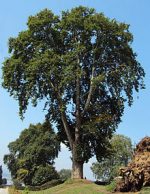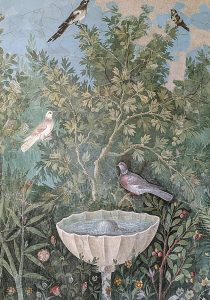 Native to riparian sites of southeastern Europe to western Asia, this long-lived deciduous tree is also known as oriental plane and is a member of the small Platanaceae family that also includes London plane tree and American sycamore. The “Tree of Hippocrates” in ancient Kos and the grove of trees in ancient Athens may have been plane trees. The ancient Roman naturalist, Pliny the Elder (d 79 AD) tells us that the Greeks introduced the tree for its shade first into the Tremiti Islands, then into Sicily, and finally into peninsular Italy. Dionysius the Elder, tyrant of Syracuse, used the tree to decorate the palaestra of his residence in Rhegium and established the decorative use of the tree in the Roman world. Other Roman writers extol the virtues of the plane: Ovid speaks of the “genial plane tree”, Vergil that it offers shade to wine drinkers, and Horace that he lies in careless ease under the tall plane. Pliny the Younger tells us that four plane trees shaded the courtyard garden of his Tuscan villa and archaeological evidence suggests that the ancient Pompeiins and their neighbors may have enjoyed the plane trees too. Tree root cavities were found in Regio II of ancient Pompeii and impressions of leaves were discovered in volcanic material deposited at Stabiae. A fresco in the House of the Golden Bracelet in Pompeii shows a plane tree behind a fountain with birds in its branches. Shade is the most probable characteristic of the plane that endeared the tree to the ancient Romans but the tree was also considered medicinally valuable. Pliny the Elder describes 25 remedies using preparations from the bark, leaves and excrescences of the tree to treat a variety of problems from freckles, burns, and stings to frostbite, inflammation, and hemorrhaging. Photo Credit Wikipedia
Native to riparian sites of southeastern Europe to western Asia, this long-lived deciduous tree is also known as oriental plane and is a member of the small Platanaceae family that also includes London plane tree and American sycamore. The “Tree of Hippocrates” in ancient Kos and the grove of trees in ancient Athens may have been plane trees. The ancient Roman naturalist, Pliny the Elder (d 79 AD) tells us that the Greeks introduced the tree for its shade first into the Tremiti Islands, then into Sicily, and finally into peninsular Italy. Dionysius the Elder, tyrant of Syracuse, used the tree to decorate the palaestra of his residence in Rhegium and established the decorative use of the tree in the Roman world. Other Roman writers extol the virtues of the plane: Ovid speaks of the “genial plane tree”, Vergil that it offers shade to wine drinkers, and Horace that he lies in careless ease under the tall plane. Pliny the Younger tells us that four plane trees shaded the courtyard garden of his Tuscan villa and archaeological evidence suggests that the ancient Pompeiins and their neighbors may have enjoyed the plane trees too. Tree root cavities were found in Regio II of ancient Pompeii and impressions of leaves were discovered in volcanic material deposited at Stabiae. A fresco in the House of the Golden Bracelet in Pompeii shows a plane tree behind a fountain with birds in its branches. Shade is the most probable characteristic of the plane that endeared the tree to the ancient Romans but the tree was also considered medicinally valuable. Pliny the Elder describes 25 remedies using preparations from the bark, leaves and excrescences of the tree to treat a variety of problems from freckles, burns, and stings to frostbite, inflammation, and hemorrhaging. Photo Credit Wikipedia
 Description: The deep rooted tree may grow up to 120′ but is usually less than 90′ tall and has a spreading crown, horizontal branching, and a single trunk with flaking, scaly, gray-brown bark. The palmate, maple-like leaves have 5-7 distinct lobes and coarsely toothed margins, and may provide red, amber and yellow color in the fall. Globose clusters of male and female greenish flowers appear in spring on the same tree and pollinated female flowers give way to 1 3/8″ wide balls of small, one-seeded fruits that ripen in the fall and persist into winter. Photo Credit Wikimedia Commons
Description: The deep rooted tree may grow up to 120′ but is usually less than 90′ tall and has a spreading crown, horizontal branching, and a single trunk with flaking, scaly, gray-brown bark. The palmate, maple-like leaves have 5-7 distinct lobes and coarsely toothed margins, and may provide red, amber and yellow color in the fall. Globose clusters of male and female greenish flowers appear in spring on the same tree and pollinated female flowers give way to 1 3/8″ wide balls of small, one-seeded fruits that ripen in the fall and persist into winter. Photo Credit Wikimedia Commons
Size: 60-90′ H x 50-70′ W
Light: Full sun
Soil: Average, consistently moist to wet, neutral to alkaline; slightly drought tolerant when established.
Hardiness: Zones 7-9